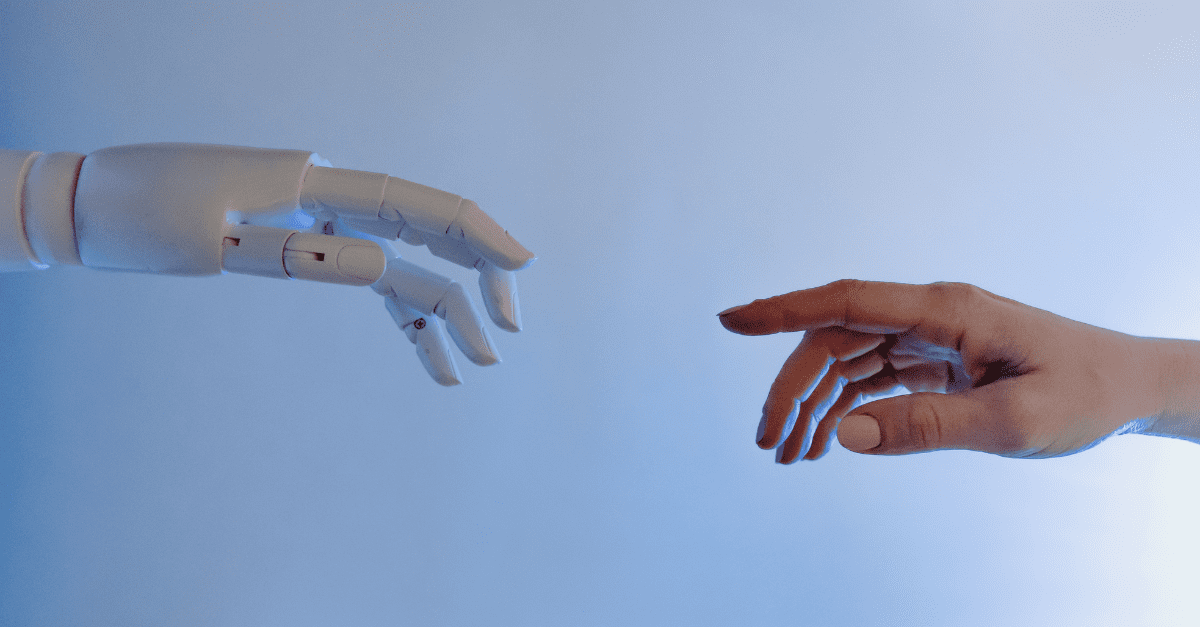Human-Centered Marketing Meets AI Efficiency: Yes, We CAN Have It All
I’ve written many blogs that explore how to use marketing to solve a business problem. This one is a little different.
With 2024 unofficially dubbed The Year of AI (at least on Wall Street), I find myself contemplating how this enabling technology can coexist with the human-centered marketing experience buyers crave today. It’s a real quandary for marketers. Here’s my take.
There’s No Time to Waste
Generative AI is set to transform many industries, including marketing. And while we’re still in the Wild West days—as evidenced by the New York Times’ lawsuit alleging copyright violations by OpenAI—the transformation is happening at warp speed. Marketers don’t have the luxury of sitting on the sidelines and waiting to see how it plays out. We need to solve the problem now.
But first…let’s define the problem.
While many are fretting about generative AI replacing employees, that doesn’t seem likely. For marketers, the real issue is how to meet the buyer’s need for a humanized, personalized buying experience at a time when technology threatens to overtake our interactions.
Digital and Personal Can Co-Exist
At every turn, buyers are showing they want a more human-centered buying experience. Younger, digital natives are moving into the decision-maker’s seat for B2B purchases, fueling most of the buying process to happen digitally. While that might not sound very personal, 83% of B2B buyers believe personalization improves the digital buying experience.
At a time of digital overload, buyers crave human connection. While they don’t appreciate it when companies force a sales conversation too soon, B2B buyers DO want a more social, entertaining experience. Just like Amazon knows what you’re likely running out of and need to order next, buyers expect the same personalization with B2B purchases. They expect technology to align B2B buying with their individual preferences, delivering personalized offers and serving up tailored search engine results.
But Here Comes AI
Yet technologies like gen AI are threatening to pull marketing in a different direction, one where humanization takes a back seat. For example, Gartner forecasts that 30% of outbound marketing messages that originate from large organizations will be synthetically generated—not 10 years from now, but by next year!
Two opposing trends are rapidly intersecting: Buyers are craving more humanized marketing, and AI is beginning to de-humanize marketing. Sounds like a recipe for marketing disaster, right?
It depends.
What’s Better: Human or Machine?
Most things in life don’t fall on the extreme ends of the spectrum, and so it is with this quandary. I firmly believe the solution to meeting the B2B decision-maker’s buying preferences won’t come down to all-human or all-machine. We’ll need to strike the proverbial balance. It will be messy and difficult, as most problems are.
A look at both extremes shows why it’s unlikely we’ll end up living at either end.
All-human was really the only option when I founded Marketri 20 years ago. I spent a lot of time interacting with clients on site, fueling my knowledge of their brands and feeding my inspiration. I lovingly hand-crafted every email campaign, sales letter, webpage, and piece of collateral. And marketing automation was still just the germ of an idea.
All-human was original, reducing the risk of plagiarism or copyright infringement. It was highly creative, resulting in original campaigns that differentiated companies. And it reflected the client’s unique point-of-view and subject matter expertise. But it was difficult to scale, didn’t always align with buyer behavior, and didn’t use tech-enabled techniques to optimize marketing for the best results. Because the message wasn’t personalized, high unsubscribe rates and low open rates were the norm. And because it relied on humans who could only generate so much creativity, mental roadblocks were inevitable.
All-machine, the other extreme, is the direction some marketers fear we’re headed. The combination of established marketing technologies (like HubSpot) plus generative AI tools like ChatGPT and AI-driven chatbots have the potential to replace much of the human aspect of marketing. And it’s not just impacting marketing execution; more companies are serving up all AI-created content, too.
On the plus side, generative AI provides leverage for improving marketing and sales functions. Beyond automating routine tasks, when AI has access to the right data sets it can personalize outreach, tailor messages, and time their delivery down to the individual. It puts predictive analytics into the hands of the layman, no longer dependent on a data analyst for useful insights. And when it comes to sifting through mountains of research to inform content, machine beats human, hands-down.
But content that’s fully AI-generated won’t do the trick. Aside from the accuracy and bias issues that are coming to light, and the risk of copyright infringement by large language models, AI-generated content brings zero insight, intuition, original thought, or strategic thinking. It’s simply compiling what’s already been published, based on what it’s been trained to look for.
You can’t profess to be a thought leader if you’re simply regurgitating what everyone else said. And you can’t take a position on a subject that’s important to your buyers (like I’m doing right now) if you’re just repackaging generic information. And let’s not even ponder what happens if we let AI tools do all the thinking for us. Creativity, innovation, and critical thinking will surely nose dive.
It’s All About Balance
Businesses can’t risk harming their brands by delivering generic, inaccurate, biased, or unethical content. They can’t alienate B2B buyers who crave a personalized, human-centered experience. And they can’t afford to lose their differentiation by losing their creativity and insight.
So how do we solve the quandary of B2B buyers demanding more creative and personalized messages at the right time and place, ensuring those messages stand out in a saturated digital landscape, and leveraging technology to do it all intelligently and efficiently?
As with most things in life, it’s all about balance: Finding a happy medium between human and machine. There’s no ideal ratio, so it will take trial and error to get it right.
Lean too far to the human side, and you won’t have the tools to personalize, humanize, and automate the buying experience, nor the data to deeply understand the buyer’s journey.
Lean too far to the machine side, and you won’t be relevant, creative, or original—a sure recipe for sameness and failure.
Marketers will need to level up and think critically about where along the human/machine spectrum they should lie. What’s the best use of gen AI and other technologies for your business, based on your strategy, objectives, and buyer personas? How can you use technology to free up more time and brainpower for creative, original, strategic thinking?
It’s going to take time and energy to get to the right solution. But the results will be well worth it: More creative, relevant marketing, delivered to the right buyers at the right time, optimized using the best data analytics and automation tools at our disposal.
Buckle up for the ride!





